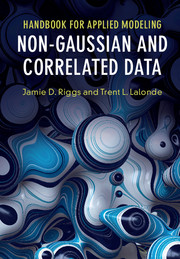Book contents
- Frontmatter
- Dedication
- Contents
- Preface
- 1 The Data Sets
- 2 The Model-Building Process
- 3 Constant Variance Response Models
- 4 Nonconstant Variance Response Models
- 5 Discrete, Categorical Response Models
- 6 Count Response Models
- 7 Time-to-Event Response Models
- 8 Longitudinal Response Models
- 9 Structural Equation Modeling
- 10 Matching Data to Models
- Bibliography
- Index
3 - Constant Variance Response Models
Published online by Cambridge University Press: 03 August 2017
- Frontmatter
- Dedication
- Contents
- Preface
- 1 The Data Sets
- 2 The Model-Building Process
- 3 Constant Variance Response Models
- 4 Nonconstant Variance Response Models
- 5 Discrete, Categorical Response Models
- 6 Count Response Models
- 7 Time-to-Event Response Models
- 8 Longitudinal Response Models
- 9 Structural Equation Modeling
- 10 Matching Data to Models
- Bibliography
- Index
Summary
Introduction
In this chapter we discuss the use of normal multiple linear regression models. The models are said to be normal because we assume the errors (and consequently the responses) are distributed normally. The term multiple refers using more than one predictor to account for the variation in the response variable. We say the models are linear in the parameters as described in Chapter 1. The prediction functions do not need to be linear, but the regression coefficients cannot be involved in any nonlinear expressions. Regression refers to the estimation method that regresses a data-fitted line toward the true line which rarely is achieved or known.
Recall that a model is useful only if the data and variables are appropriate to the subject matter. When this is the case, we may construct a model for which we expect the predictors to influence changes to the response.
Multiple predictors are important for describing changes in the response variable for two primary reasons: processes for modeling are rarely simple, and multiple numbers of predictors usually more thoroughly partition the variance exhibited in the response. Pairing individual predictors with the response to assess pairwise correlations averages out variation due to other omitted predictors, leaving the amount of unexplained variance large. Often the level of a response is better understood when two or more predictors interact. The level of one predictor may alter the correlative relationship with some other predictor on a response. Another reason for multiple predictors in a predictive regression model is it often better accommodates new data.
We examine the ability of normal multiple linear regression to produce viable models on each of the four data sets presented in Chapter 1.We subject each data set to normal multiple linear regression for two reasons: firstly, we have assumed that users of this handbook are familiar with basic statistics and normal multiple linear regression; and secondly, we use these analyses as a baseline, or reference, from which to compare the outcomes of the models presented in Chapter 2. These outcomes are presented in the chapters following this one.
- Type
- Chapter
- Information
- Publisher: Cambridge University PressPrint publication year: 2017



